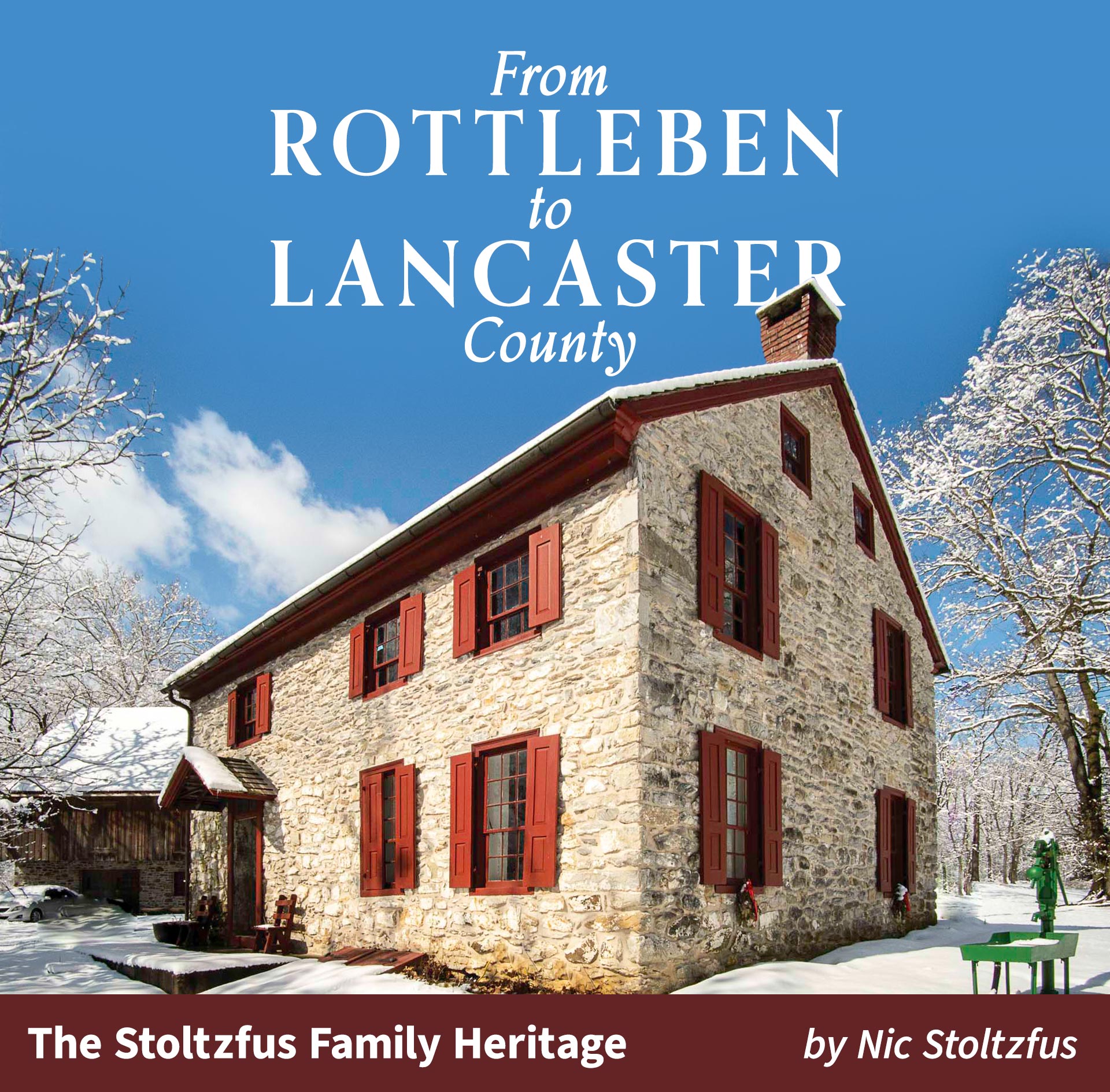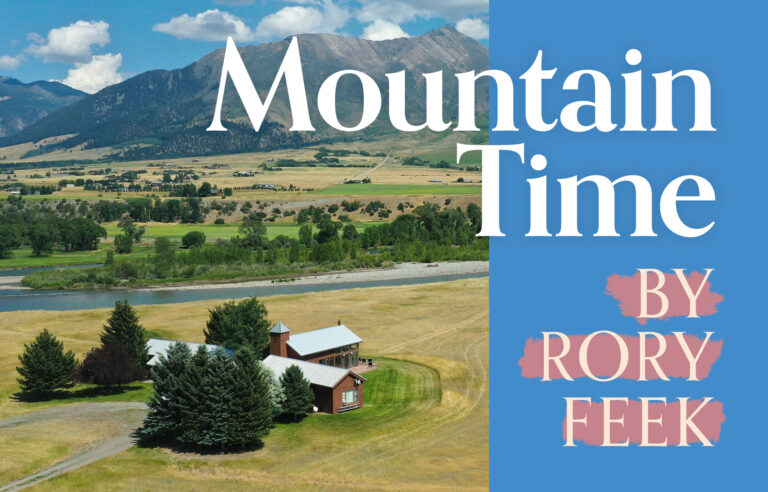by Nic Stoltzfus, Plain Values
I first moved to Pennsylvania in the fall of 2018 to become caretaker of the Nicholas Stoltzfus Homestead in Reading. I was also nearing completion of a coffee-table book I was working on: German Lutherans to Pennsylvania Amish: The Stoltzfus Family Story. I was unsure about how it would go—although my father Elam was born Amish in Lancaster County and grew up there, I was a stranger to this region. I had never spent more than two weeks in Pennsylvania my whole life and didn’t know much about Amish culture and way of life. After all, I was a Floridian who was raised on grits and sunshine, not snow and scrapple.
I made it my mission to learn as much as I could about my Amish and Stoltzfus heritage, and this past year I learned a great deal.
+
The central figure around whom this project was swirling was Nicholas Stoltzfus, the immigrant, and my namesake. In many ways, he was the linchpin that held together the key concepts of my book; the German Lutherans and the Pennsylvania Amish.
Nicholas’ ancestors were of the Lutheran faith, and they were deeply committed to it. His great-grandfather, Johann Adam Steltzfuss, was an ordained Lutheran minister, as was his grandfather, Christoph Gottlieb Sr. Together, as father and son, they served as ministers of a small Lutheran church in Rottleben, a village in eastern Germany. This is where Nicholas’ roots trace back to: Lutheran and German, as opposed to the Swiss Anabaptist heritage of most other Amish and Mennonites.
Switzerland is over 400 miles away from where the Stoltzfus family originated; how then did they cross paths with the Amish?
It was Nicholas’ father, Christoph Gottlieb Jr., who left his homeland behind. He was an orphan at a young age since his parents both died in their thirties. Because of this, he likely had to make his own way in the world. Christoph became a wigmaker, a step down the social ladder from his forefathers, who were ministers in the established Lutheran church. At the time, the city of Zweibrücken had an elaborate court; perhaps he relocated to provide his services to the nobility there. Anabaptists were also living in Zweibrücken, having migrated there from Switzerland via France. The ruling class had invited them there because they were skilled farmers.
Tragically, Christoph Jr. also died young, at age twenty-nine. Nicholas was the only child. His mother, Catherina Rosina (Bergmann) Stoltzfus, soon remarried and had four children with her husband, Daniel Bellaire.
Like generations before him, Nicholas was raised a Lutheran. He was baptized as an infant, confirmed into the church as a teenager, and was even asked to be a godfather for an infant girl when she was baptized into the local congregation.
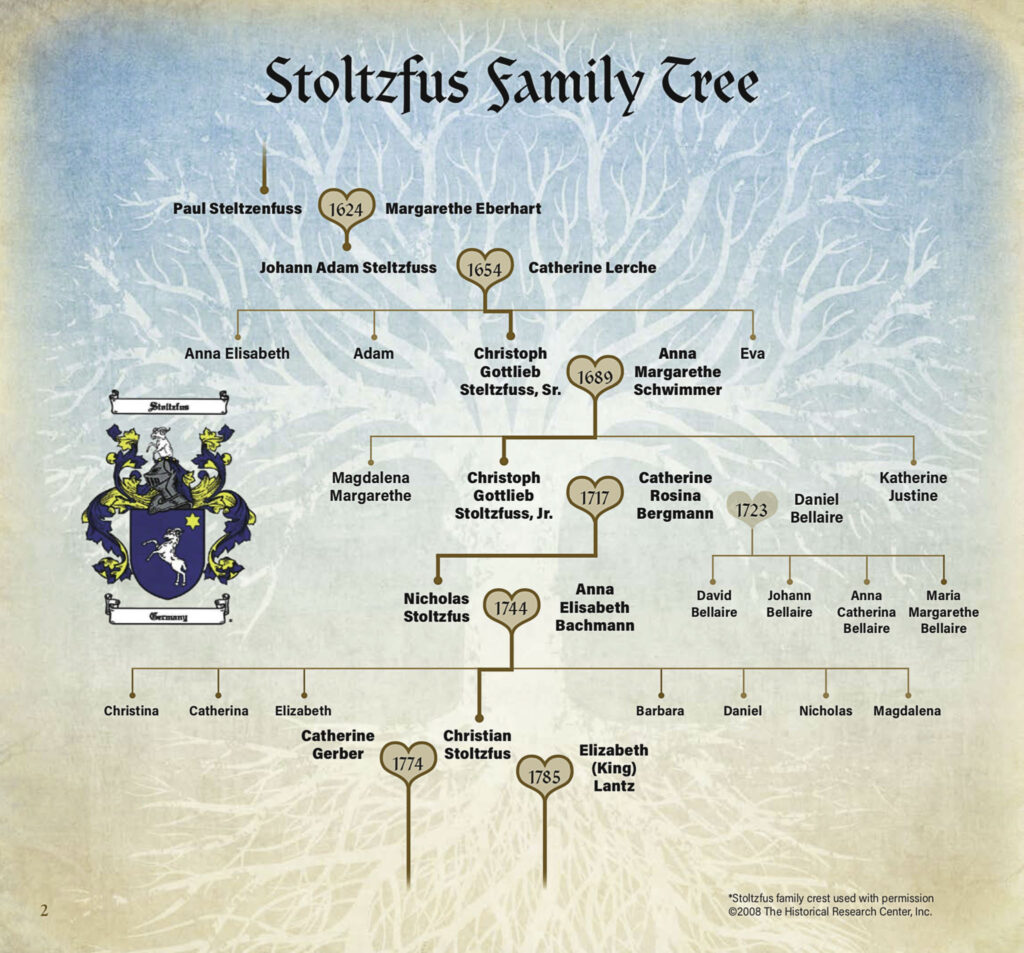
It seems like Nicholas didn’t have it easy; as a young man, he admits that he didn’t expect any inheritance from his mother and stepfather. There may have been too many mouths to feed; if that was the case, perhaps he was the one lost in the shuffle, being the stepson. Maybe he sought affection and love outside the home; as a teenager, he fathered a child out of wedlock.
Nicholas left home and went to work for farmers in France. It was there where Nicholas came into contact with Anabaptists, who were the majority of the farmers in the area. Nicholas writes, “I became familiar with their quiet ways and embraced them as my own…”
This statement shows that these Anabaptists provided Nicholas with more than just a job; they also gave him love and affection. He was a stranger, and they took him in.
As a young man, Nicholas began working for a Mennonite farmer closer to home. Christian Bachmann managed the Ringweiler farm a few miles outside Zweibrücken, and Nicholas married his daughter Anna Elisabeth in 1744.
For two decades, they raised their family in Germany but decided to leave for Pennsylvania in 1766. Many other Amish and Mennonite families had left earlier—lured by the ability to own land, lower taxes, and greater religious freedom.
The records show that when the Stoltzfus family was in Germany, they were Mennonite. But when they came to America, they began to associate with the Amish. We don’t know why or under what circumstances they made the decision to join with the Amish, but this is the faith that the Stoltzfus family chose.
Three of their children married into the Amish faith: daughter Anna married Christian Fohrer, daughter Barbara married John Schmucker, and son Christian married Catherine Gerber.
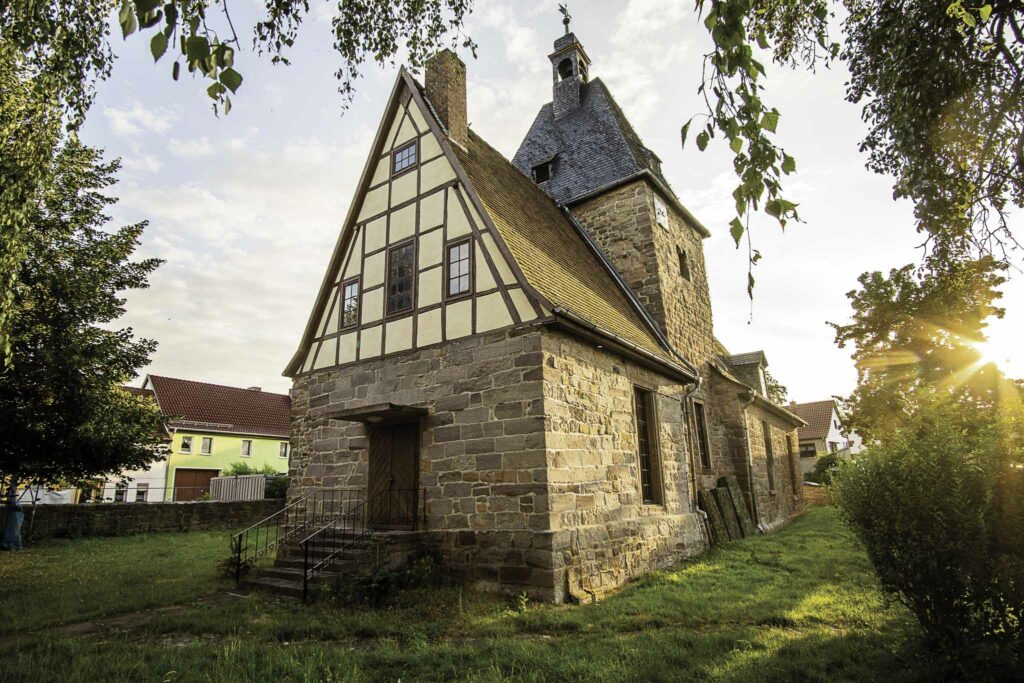
When the family had enough money to purchase land, Nicholas co-purchased land with his son, Christian. (In 1771, they co-purchased land that contained the stone house that is today known as the Nicholas Stoltzfus Homestead.) This was a way for Nicholas to provide for his son and help him get started in the world.
His son Christian embraced the values of the Amish community: family, faith, and distinctness of belief.
When his father died in 1774, Christian was entitled to a double portion of the inheritance. However, he declined the double portion and, instead, agreed to have it split evenly amongst himself, his three sisters (Anna, Barbara, and Magdalena), and his widowed mother. Like his father before him, Christian also helped out his son John by co-purchasing a farm for him in Lancaster County.
Together, Christian and John served as bishop and minister of the West Conestoga church district in the early 1800s. In 1809, Christian met with other Amish church leaders to solidify some of the early rules of the church: the document includes articles about shunning, simplicity of dress, not serving on juries, and not swearing oaths.
Christian Stoltzfus passed away in 1832 at the age of eighty-two. When he died, he was survived by thirty-four grandchildren and thirty-five great-grandchildren. This number continued to grow so that, today, Stoltzfus is the most common last name amongst the Old Order Amish in Lancaster County.
+
This past year I have thought a lot about decisions. What if? What if? What if? I think to myself—What if Nicholas’ father had remained in Rottleben? What if Nicholas had married a Lutheran woman instead of the Mennonite farmer’s daughter? What if the Stoltzfus family had chosen to remain in Germany or travel to Russia instead of going to America? What if Nicholas and Anna Elisabeth decided to remain Mennonite instead of joining with the Amish?
The decisions of our ancestors continue to impact us even today. Likewise, the decisions we make have an impact on future generations. This is why we ponder the past and why we read stories of our ancestors—to serve as lights as we walk along our journey.
As we look back in time through the lens of history, we see glimpses of who our ancestors were. They weren’t perfect, but rather clay-footed people as prone to stumbling as you or me. And yet I see people who were trying, in their own way, in their own time, to live a good and godly life.
May the lives of our ancestors illuminate our own paths as we continue to strive for the values they cherished: to love our neighbor as we love ourselves, to take care of our family, and to live out our faith day-by-day.
+ + + +
This is the translation of Immigrant Nicholas Stoltzfus’ petition to the Duke of Zweibrücken to marry Anna Elisabeth Bachmann. He was not allowed to marry her because he was Lutheran and she was Mennonite, so he had to get permission from the government to marry outside his faith. In the petition, Nicholas gives a brief account of his life.
About my petition to the district to marry the daughter of the Ringweiler farmer, who is an Anabaptist, I have been referred to the Duke’s government [to ask] for permission for this reason: because my parents do not belong to this religious party but rather [that of] my father, Christoffel Stollfuss [Christoph Stoltzfuss], who died in Saxony, and my mother, the wife of the pond digger Belleur [Bellaire], is the Lutheran Religion.
And after my mother’s return to this land following my father’s death, I at times had to serve among foreigners living on the farms at and around Wissembourg where I stayed for a time and had the opportunity and, because they were inhabited with no others than Anabaptists, I became familiar with their quiet ways and embraced them as my own and have retained them until now and went to such people at Ringweiler to work for them.
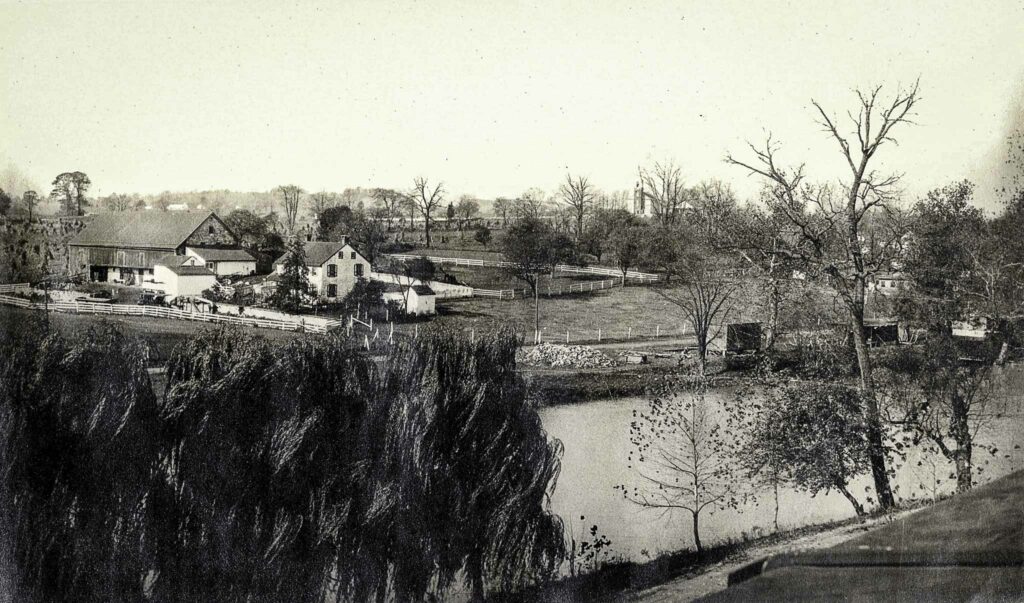
Yes, and the causes for my decision to marry are that I am 25 years old and have nothing [no inheritance] to hope for from my parents and through such a marriage expect to succeed in my subsistence. Since if my humble request is granted, it can only be more of a help to my condition than a hindrance, [I request] that the marriage be permitted.
Nicolaus Stoltzfus, Zweibruecken, January 14, 1744.”
Translation by Rosalind Beiler
+ + + +
The following is an excerpt from “The History of the Nicholas Stoltzfus Homestead,” which is Part II of Nic’s book.
On a spring morning in 1997 in Morgantown, Lois Ann Mast stood by the door of a burgundy bus handing information packets to people boarding the bus. The people on the bus, who numbered around fifty, were participating on a tour of Amish-Mennonite historic sites in Berks County. Lois Ann’s husband, Lemar, led the tour along with local historian, Paul Kurtz. Like Lemar, Paul had a deep knowledge of the history of early Amish-Mennonites in Berks County. His father, C. J. Kurtz, had led some of the earliest tours to historic Amish-Mennonite homesteads and points of interest in Berks County.
After leaving Morgantown, the bus stopped at a few sites in Shillington, then went up to see the Schmucker Homestead in Wyomissing, across the Schuylkill River from Reading. Lemar and Paul led the group around the stone house—now managed by the Borough of Wyomissing—and pointed out the stone plaque noting that John Schmucker and Barbara Stoltzfus Schmucker once lived here. The group admired the restored stone house and neighboring pond, babbling into Wyomissing Creek. The scenic park was a favorite among locals, who skated on the pond during the winter and celebrated Independence Day picnicking on the lush summer grass.
From here, the group boarded the bus and headed three miles north towards the Nicholas Stoltzfus Homestead. As the bus rumbled down Tulpehocken Road, the people onboard looked out their windows. They were shocked by what they saw: a haunted-looking building covered in a jungle of vines and weeds.
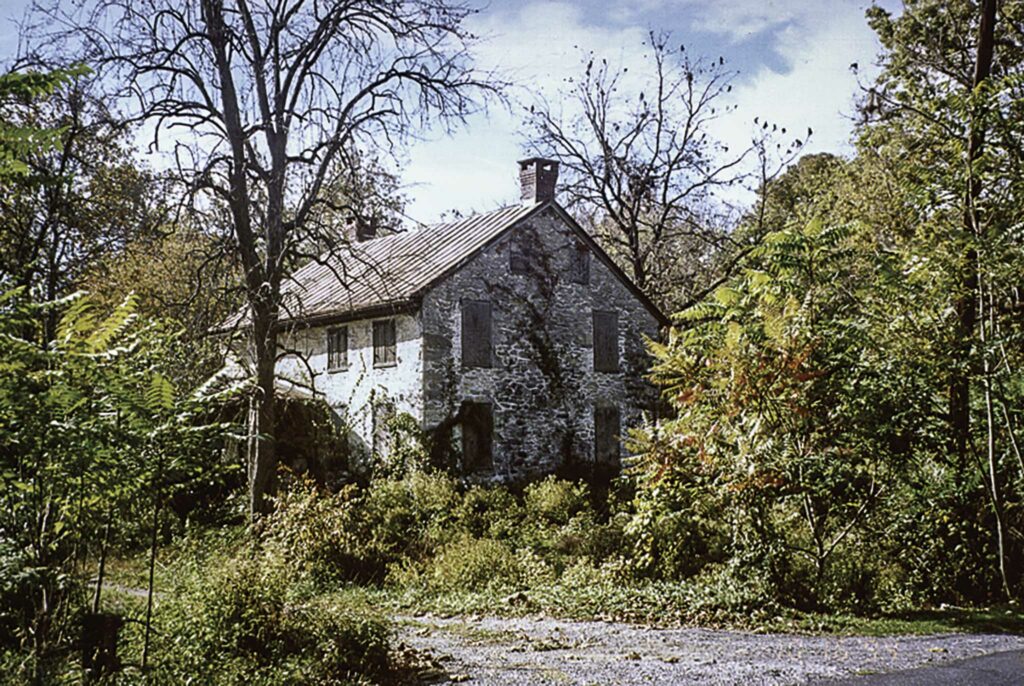
Paul and Lemar led the intrepid group through the thick brush that covered the property. Plywood covered the windows and the tin roof was stained with rust. Paul opened the front door to a house that had been unoccupied for nearly a decade. Their dismay mounted—the paint was peeling off the walls, raff dangled from the ceiling, and the air smelled dank and musty.
Many in the bus were descendants of Nicholas Stoltzfus, and to see the home of their ancestors—once a clean and happy home where families lived, laughed, and worked these very grounds—in such a broken-down state was hard to see. Over lunch at Roadside America and supper at Conestoga Mennonite Church, many conversations centered around this homestead and what could be done to preserve it.
People on the 1997 Masthof tour talked about their plans to preserve the house with friends and family. But they weren’t the only ones working to preserve the house. Along a parallel track, members of the Pequa Bruderschaft Library—a library founded and managed by Old Order Amish historians—had also made visits to the homestead and wanted to see it preserved, as well.
+
After the Nicholas Stoltzfus Homestead Preservation Committee was granted the license to restore the homestead, they had a date in mind to finish it: fall 2002, in time for the 250th anniversary of Berks County. This was an ambitious timetable, with less than two years to finish the exterior restoration work.
After Jacob Riehl and his crew repointed the stones, the Committee turned their attention to the windows. The boards over the windows were removed, along with the windows themselves, which were in bad shape. New window frames were installed: Sam D. Stoltzfus donated the wood for the frames, and Lemar Mast built the frames with help from his father Horace and son Daniel. After fitting the frames, Lemar painted them tinner’s red, a vibrant hue that complemented the freshly-cleaned stone walls.
By July 2002, the house was ready for the finishing touch: replacing the roof. The old tin roof and rotting wood shingles underneath were removed and replaced with old-fashioned cedar shake shingles. After the work was done, the volunteers stood by in the sweltering summer heat, admiring their handiwork.
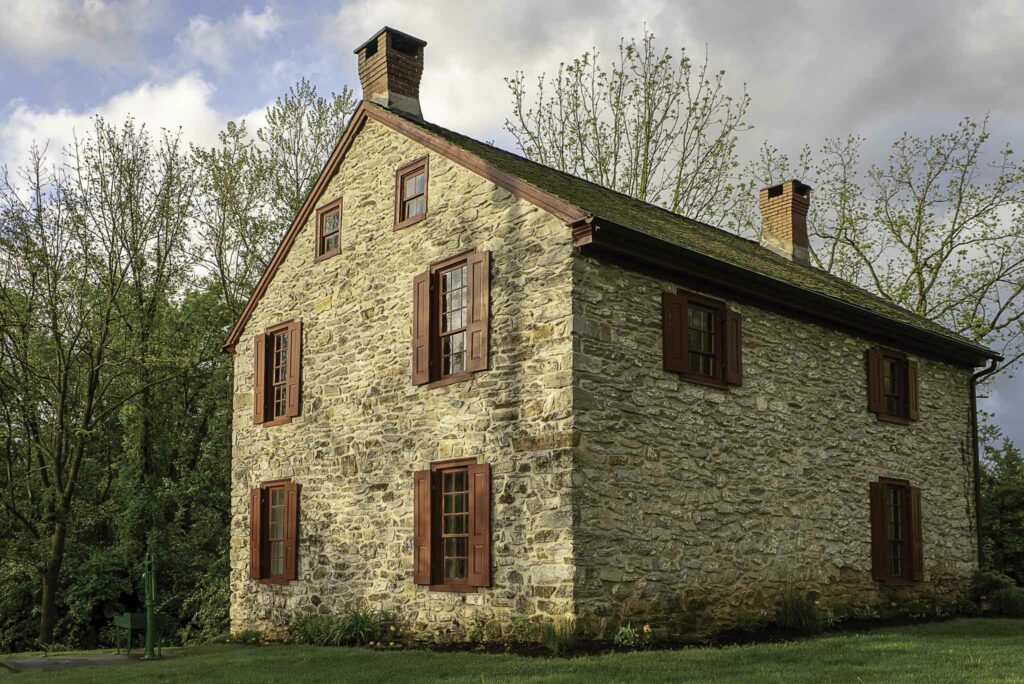
On October 5, 2002, two tours visited the recently-restored homestead: the Berks County Conservancy with their “250th Anniversary of Berks” tour and Masthof’s “Amish-Mennonite Heritage Tour,” again led by Lemar Mast and Paul Kurtz. For Lemar and Paul, their tour was particularly meaningful. Only five years earlier, the house had been in ruins. Paul squinted his eyes at the restored house. He could almost imagine Nicholas Stoltzfus walking through the front door. If only his father could see how good the house looked today!
The following February, the Nicholas Stoltzfus Homestead Preservation Committee held their second annual banquet at Yoder’s Restaurant in New Holland. After singing the traditional Amish song from the Ausbund, the “Lob Lied” or Love Song, nearly fifty people listened to various presentations related to the homestead and the Stoltzfus family. Jack Parmer shared his findings about the architecture of the house; Chris P. Stoltzfus shared about his trip to Germany to find out more about the Stoltzfus ancestry there; and Sam S. Stoltzfus shared his poem “Der Tulpehocken Zu Der Stoltzfus Haus”, as told from the perspective of the Tulpehocken Creek.
Sam ended his poem with these final three stanzas:
Soon briars and weeds take over,
O my, I fear for the house.
Then I hear Leader Homes,
and there’s building next door.
Next I see broad brimmed hats,
poking through the house.
Up goes a sign, Pequea Bruderschaft Library,
then there’s more.
The Stoltzfuses have been with broom and shovel.
Windows are fixed, walls repaired,
a pump in the well.
The old stone house suddenly has a new spirit.
The clean’in and fix’in did more
than words can tell.
O what fun to flow by the happy house now.
Seems the birds sing more,
wild flowers in full array.
I hear Tri-County Heritage Society,
the preservation committee.
I’ll say thanks again, surely the house will stay.
To visit the restored Homestead, schedule a tour with the caretaker by calling 484-878-2916. The Homestead is also open the first Saturday of May, the date of the annual benefit auction.
This article was published in the January 2020 issue of Plain Values Magazine. If you want the latest stories every month, subscribe to the magazine at plainvalues.com. As a special thanks, get 10% off your subscription with the code “GAB23”!

Nic Stoltzfus and his wife Jen live in Reading, Pennsylvania, with their three crazy cats and rescue dog, Paul. They hope to have children soon! Nic loves volunteering in his community—he is teaching Sunday school next spring, is involved with the Schuylkill River Passenger Rail Authority’s plan to bring back passenger rail to Berks County, and he serves as secretary of the Nicholas Stoltzfus Homestead Preservation Committee. He is currently working on a novel about the immigrant Stoltzfus family.


